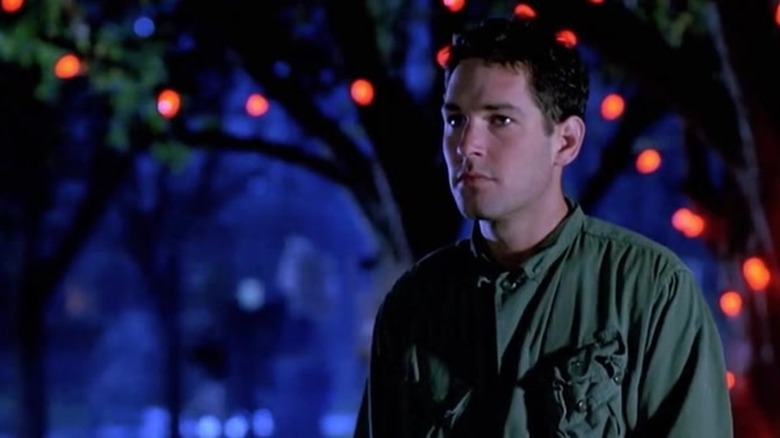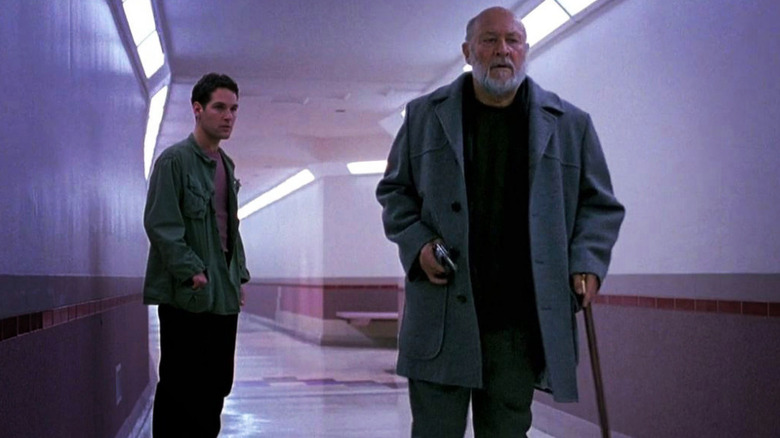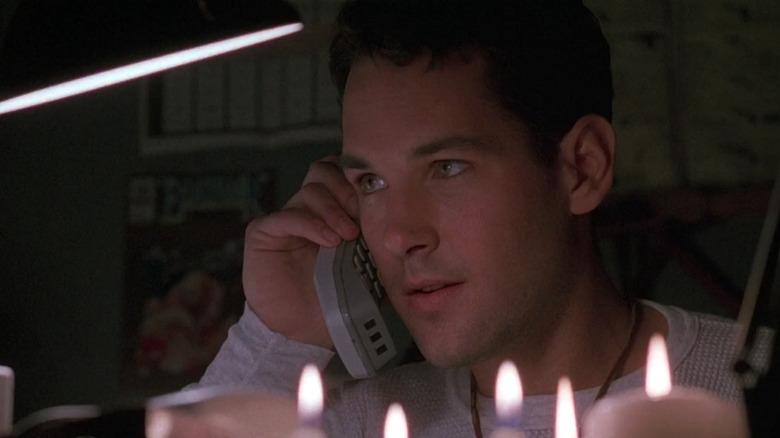Paul Rudd Got His Hollywood Start In The Halloween Franchise's Biggest Flop
Paul Rudd made his big-screen debut in Amy Hecklering's high-profile modernization of Jane Austen's "Emma," "Clueless" in 1995. He immediately gained a great deal of attention because he was very handsome, and he was very funny. Fun trivia: Rudd was 25 when he filmed "Clueless" in 1995 and, in 2024, he somehow only looks 31. Before "Clueless," Rudd appeared in a Super Nintendo commercial, and he had a recurring role in later seasons of the soap opera "Sisters." He also starred in all six episodes of the short-lived 1994 Fox sitcom "Wild Oats." These days, Rudd is a massive movie star, having established himself as one of the better comedic actors of his generation, and becoming involved with the gigantic Marvel Cinematic Universe, playing Ant-Man.
But he wasn't always playing with power. Many actors make their way into the mainstream through the portal of horror, starting their careers in slasher movies and ghost stories. Adam Scott, for instance, appeared in "Hellraiser: Bloodline" in his early days. Leonardo DiCaprio turned up in "Critters 3" when he was young. One of Matthew McConaughey's earliest roles was in "The Texas Chainsaw Massacre: The Next Generation," and Johnny Depp made his big-screen debut in "A Nightmare on Elm Street." Even George Clooney paid his dues by appearing in "Grizzly II," "Return to Horror High," and "Return of the Killer Tomatoes!" And, naturally, Jamie Lee Curtis got her start in John Carpenter's classic 1978 slasher "Halloween."
The actor followed in Curtis' footsteps. The same year as "Clueless," Paul Rudd appeared as Tommy Doyle in Steve Miner's "Halloween: The Curse of Michael Myers," the sixth "Halloween" movie, and handily one of the worst. Which is saying something, because many of the "Halloween" sequels are pretty terrible.
Tommy Doyle, all grown up
Tommy Doyle, as one might recall, was the young boy that Laurie (Curtis) was babysitting in the 1978 "Halloween," and who was one of the first witnesses to Michael Myers' murders. In 1978, the character was played by Brian Andrews. In "The Curse of Michael Myers," Rudd plays the young boy all grown up, now obsessed with figuring out the motives of the serial killer Michael Myers (George P. Wilbur).
Thanks to the indecipherable chronology of the "Halloween" movies, the character was also played by Skyler Gisondo and Anthony Michael Hall, although "Curse" pre-dates several rebooted continuities.
The story of "Curse" is almost impossible to follow, as production was notoriously chaotic, and the film was edited to ribbons in post-production. In brief, Tommy discovers that Michael Myers is no mere boogeyman, but in the thrall of a curse that transformed him into an immortal assassin. The Curse of Thorn drives Michael to kill his own family, and he is under the control of local cultists who operate out of a local sanitarium. There's an additional subplot about Michael's mysterious handler, Dr. Wynn (Mitch Ryan), and his attempts to clone Michael (!). Oh yes, and Tommy also possesses a handful of runic stones that, when placed around Michael, paralyze him.
It's wild to think how trim and simple John Carpenter's "Halloween" was when compared to "Curse." The "Halloween" series started with a boogeyman, driven only by evil, but by the sixth film, there are cloning and magic stones.
It's also kind of a miracle "Curse" was made at all. Miner's film experienced a long, painful development process that involved a bidding war over the whole "Halloween" series, and multiple sloppy drafts of the script, one of which was said to take place in outer space (!).
Reshoots, etc.
The original ending of "The Curse of Michael Myers" was hated by test audiences, as it saw the stalwart old Dr. Loomis, played by Donald Pleasance in his last role, falling under the Curse of Thorn. It was implied that he would become Michael Myers' new handler, despite spending his adult life trying to stop the killer. When that ending tested poorly, the producers chose to shoot new footage, but by then, Pleasance had already passed away.
A new cinematographer was hired, and, bafflingly, the script was almost completely rewritten during the reshoot phase. The producers were fired, and the subplot about DNA-tinkering doctors was inserted. The ending was massively shaved down, and the final shot of Michael Myers' mask on the ground was improvised on the day. Even Michael Myers was recast, with A. Michael Lerner taking over for Wilbur. Several pages of the new script were never even filmed, thanks to a rushed reshoot schedule. The final theatrical cut is a mess and, perhaps predictably, difficult to follow. It wouldn't be until 2014 that a special edition Producer's Cut of "Halloween: The Curse of Michael Myers" would be released to the public.
"Curse" was a modest success. It only made about $15 million at the box office, but it only cost about $5 million to make. Critics, however, were aggressively unkind, citing the absurdity of the film's ideas, and the sloppiness of its editing. As of this writing, "Curse" has a mere 8% approval rating on Rotten Tomatoes, based on 37 reviews. That's the lowest approval rating in the series, and few of the films were reviewed well.
Rudd, meanwhile, was supposed to have a cameo in David Gordon Green's 2018 "Halloween" reboot. According to an article in Inverse, producer Ryan Turek asked for Rudd but found he was busy. He was too big a star to come back. And perhaps he didn't want to celebrate a cruddy slasher he made back in 1995.


